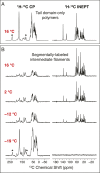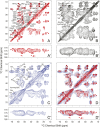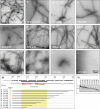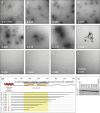Dynamic structural order of a low-complexity domain facilitates assembly of intermediate filaments
- PMID: 32907935
- PMCID: PMC7519307
- DOI: 10.1073/pnas.2010000117
Dynamic structural order of a low-complexity domain facilitates assembly of intermediate filaments
Abstract
The coiled-coil domains of intermediate filament (IF) proteins are flanked by regions of low sequence complexity. Whereas IF coiled-coil domains assume dimeric and tetrameric conformations on their own, maturation of eight tetramers into cylindrical IFs is dependent on either "head" or "tail" domains of low sequence complexity. Here we confirm that the tail domain required for assembly of Drosophila Tm1-I/C IFs functions by forming labile cross-β interactions. These interactions are seen in polymers made from the tail domain alone, as well as in assembled IFs formed by the intact Tm1-I/C protein. The ability to visualize such interactions in situ within the context of a discrete cellular assembly lends support to the concept that equivalent interactions may be used in organizing other dynamic aspects of cell morphology.
Keywords: cross-beta polymerization; intermediate filaments; low-complexity proteins; solid-state NMR.
Copyright © 2020 the Author(s). Published by PNAS.
Conflict of interest statement
The authors declare no competing interest.
Figures





Similar articles
-
Transiently structured head domains control intermediate filament assembly.Proc Natl Acad Sci U S A. 2021 Feb 23;118(8):e2022121118. doi: 10.1073/pnas.2022121118. Proc Natl Acad Sci U S A. 2021. PMID: 33593918 Free PMC article.
-
Assembly of intermediate filaments.Bioessays. 1993 Sep;15(9):605-11. doi: 10.1002/bies.950150906. Bioessays. 1993. PMID: 8240313 Review.
-
Are the Head and Tail Domains of Intermediate Filaments Really Unstructured Regions?Genes (Basel). 2024 May 16;15(5):633. doi: 10.3390/genes15050633. Genes (Basel). 2024. PMID: 38790262 Free PMC article. Review.
-
Characterization of distinct early assembly units of different intermediate filament proteins.J Mol Biol. 1999 Mar 12;286(5):1403-20. doi: 10.1006/jmbi.1999.2528. J Mol Biol. 1999. PMID: 10064706
-
Recent insight into intermediate filament structure.Curr Opin Cell Biol. 2021 Feb;68:132-143. doi: 10.1016/j.ceb.2020.10.001. Epub 2020 Nov 12. Curr Opin Cell Biol. 2021. PMID: 33190098 Free PMC article. Review.
Cited by
-
Labile assembly of a tardigrade protein induces biostasis.Protein Sci. 2024 Apr;33(4):e4941. doi: 10.1002/pro.4941. Protein Sci. 2024. PMID: 38501490 Free PMC article.
-
How do protein domains of low sequence complexity work?RNA. 2022 Jan;28(1):3-15. doi: 10.1261/rna.078990.121. Epub 2021 Oct 20. RNA. 2022. PMID: 34670847 Free PMC article. Review.
-
Liquid Droplet Aging and Seeded Fibril Formation of the Cytotoxic Granule Associated RNA Binding Protein TIA1 Low Complexity Domain.J Am Chem Soc. 2023 Jan 25;145(3):1580-1592. doi: 10.1021/jacs.2c08596. Epub 2023 Jan 13. J Am Chem Soc. 2023. PMID: 36638831 Free PMC article.
-
Identifying amyloid-related diseases by mapping mutations in low-complexity protein domains to pathologies.Nat Struct Mol Biol. 2022 Jun;29(6):529-536. doi: 10.1038/s41594-022-00774-y. Epub 2022 May 30. Nat Struct Mol Biol. 2022. PMID: 35637421 Free PMC article.
-
Single Cell in a Gravity Field.Life (Basel). 2022 Oct 14;12(10):1601. doi: 10.3390/life12101601. Life (Basel). 2022. PMID: 36295035 Free PMC article. Review.
References
-
- Ephrussi A., Lehmann R., Induction of germ cell formation by oskar. Nature 358, 387–392 (1992). - PubMed
-
- Gavis E. R., Lehmann R., Translational regulation of nanos by RNA localization. Nature 369, 315–318 (1994). - PubMed
-
- Bardsley A., McDonald K., Boswell R. E., Distribution of tudor protein in the Drosophila embryo suggests separation of functions based on site of localization. Development 119, 207–219 (1993). - PubMed
-
- Hay B., Jan L. Y., Jan Y. N., Localization of vasa, a component of Drosophila polar granules, in maternal-effect mutants that alter embryonic anteroposterior polarity. Development 109, 425–433 (1990). - PubMed
Publication types
MeSH terms
Substances
Grants and funding
LinkOut - more resources
Full Text Sources
Molecular Biology Databases
Miscellaneous

